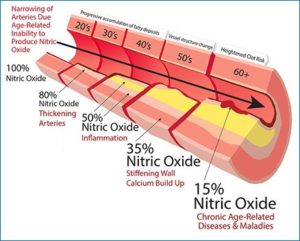 Endogenous defense against vascular injury, inflammation, thrombosis and atherosclerosis.
Endogenous defense against vascular injury, inflammation, thrombosis and atherosclerosis.
An endothelial relaxing factor that mediates favorable cardiovascular actions with the effector molecule 3,5 cyclic guanosine monophosphate (GMP).
In normal conditions, the vascular endothelial nitric oxide synthase produces nitric oxide from L-arginine in the presence of oxygen.
The key target of nitric oxide is activation of soluble guanylyl cyclase, which generates cyclic GMP.
Nitric oxide is an important signaling molecule: acts as a second messenger, as well as an intercellular messenger which regulates vasodilation, and also has functions in the immune system’s reaction to infection.
Nitric oxide diffuses into neighboring cells, including vascular smooth muscle cells and platelets, where it increases the activity of the enzyme soluble guanylate cyclase, leading to increased formation of cyclic guanosine monophosphate (cGMP) from guanosine triphosphate (GTP).
Cyclic GMP is a key intracellular second messenger that mediates protective cardiovascular, renal, neurohormonal, and metabolic actions in the maintenance of whole body homeostasis.
Released from endothelium and decreases the activation and adhesion of leukocytes, impairs platelet aggregation, thrombus formation and maintains blood vessel smooth muscle integrity by impairing vascular remodeling.
Helps modulate ischemic-reperfusion injury.
A key signaling molecule in ischemia.
Stimulates vascular smooth muscle relaxation to increase blood flow and tissue perfusion.
In low dose has proangiogenic and anti-inflammatory activities.
Increasing levels are associated with increased tissue survival in ischemic insults.
Changes in pathways detected in patients with pulmonary arterial hypertension.
Modulates vascular tone through the formulation of cyclic guanosine 3′,5′-monophosphate.
Suppresses plasminogen activator inhibitor-1 (PAI-1) production.
L-arginine is the substrate for nitric oxide synthesis.
Formed by l-arginine by one of three isoforms of nitric oxide synthase.
During conditions of low arginine concentration nitric oxide synthetase is uncoupled resulting in the production of reactive oxygen species instead of nitric oxide reducing its bioavailability in sickle cell disease with enhanced oxidative stress.
Colorless, odorless gas at room temperature and is relatively insoluble in water.
Inhaled nitric oxide has been approved for hypoxic respiratory failure in newborn infants.
Inhaled nitric oxide may have beneficial effects in acute coronary syndrome.
Inhaled nitric oxide (NO) selectively widens the lung’s arteries which allows for more blood flow to open alveoli for gas exchange, but there is no evidence that inhaled nitric oxide decreases morbidity and mortality in people with ARDS.
Furthermore, nitric oxide may cause kidney damage and is not recommended as therapy for ARDS regardless of severity.
Nitric oxide is thought to play a role the detrimental effects of air pollution on the respiratory tract.
It is an endothelium-derived relaxing factor, has role as a cell signalling molecule and neurotransmitter.
It is used in breath tests but also as a therapeutic agent for conditions such as pulmonary arterial hypertension and possibly for the acute respiratory distress syndrome.
Inhaled nitric oxide has been shown to decrease pain, opioid usage and a reduction in length of hospitalization and sickle cell disease (Wiener DL et al).
In a prospective, double-blind, randomized, placebo controlled clinical trial with 72 hours of inhaled nitric oxide gas versus inhaled nitrogen placebo in 150 participants with vaso-occlusive crisis with sickle cell disease: nitric oxide compared with placebo did not improve time to crisis resolution (DeNOVO Investigators).
The penile erection response is mediated by the release of nitric oxide (NO) from nerve terminals and endothelial cells, which stimulates the synthesis of cyclic guanosine monophosphate (cGMP) in smooth muscle cells.
cGMP relaxes smooth muscle and increases blood flow to the corpus cavernosum.
Can be measured by nitric acid strips testing the saliva or by measuring exhaled nitric acid.
